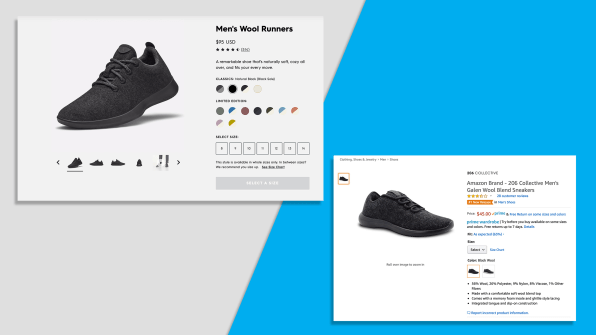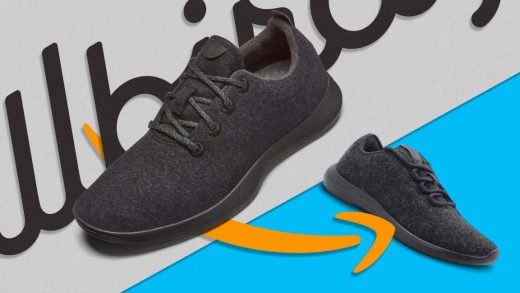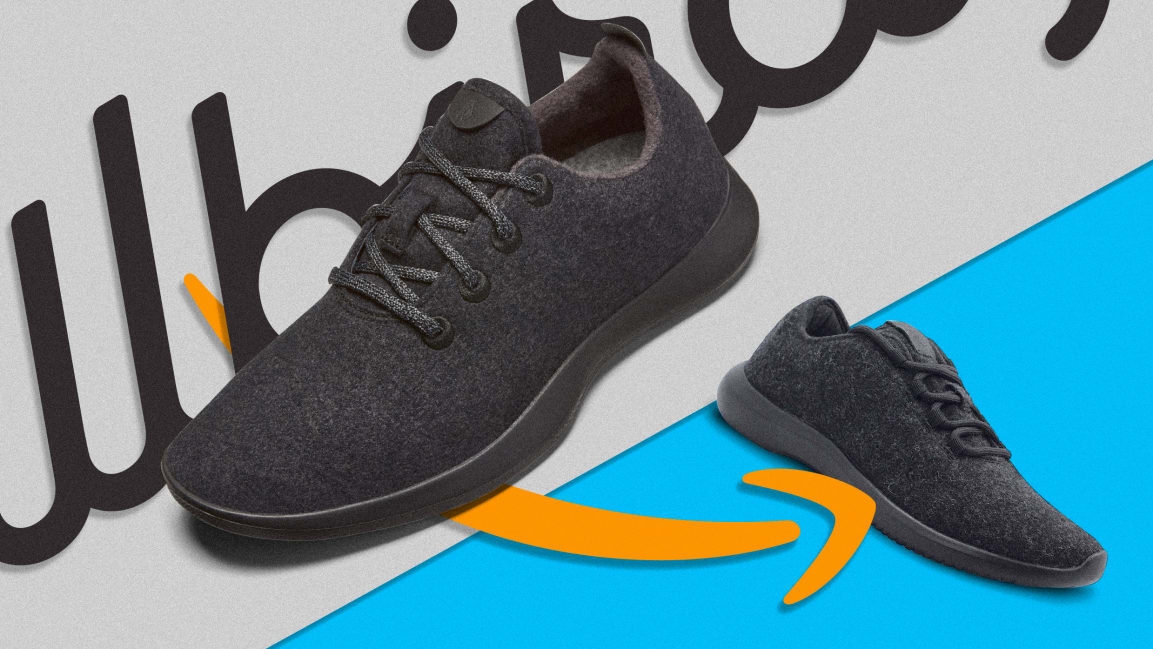Allbirds to Amazon: Don’t steal our design, steal our sustainable practices
Amazon is notorious for brazenly making cheaper lookalikes of popular products on the market, from Warby Parker glasses to the Instant Pot. The retail giant’s latest target? Allbirds, the three-year-old shoe company that has made sustainability the cornerstone of its growing sneaker empire.
Last week Amazon’s in-house shoe brand, 206 Collective, launched a shoe called the “Galen,” a wool-blend sneaker with a foam sole that looks remarkably close to Allbirds’ flagship product, the Wool Runner. Amazon’s version comes in grey, with either a white or grey sole, making the resemblance even more obvious, since these are two of Allbirds’ best-known color combinations. (Amazon declined to comment for this story.) But while Allbirds’ sells its sneaker for $95, Amazon’s version sells for $45.
Joey Zwillinger, Allbirds cofounder and co-CEO, responded to Amazon in an interview with Co.Design. It’s not the similarities in design that bother him most; it’s the fact that Amazon did not go so far as to copy Allbirds’ stringent sustainability practices. While he’d prefer that Amazon not copy Allbirds’s design at all, he’s encouraging the brand to borrow freely from his company’s eco-friendly supply chain practices, including some of the sustainable new materials Allbirds has invented.
“Given what I know about manufacturing, there is no way you can sell a shoe for that low while taking care of all of the environmental and animal welfare considerations and compliance we take into account,” Zwillinger says. “Amazon is stating that it wants to be a green company. It should be taking steps to make their products more sustainable.”
A stark juxtaposition
Allbirds, which launched in 2016 and is already valued at $1.4 billion, has become known for its eco-friendly practices. The Wool Runners, for instance, are made from merino wool certified by ZQ, a group that guarantees animal welfare and environmental sustainability. The shoelaces are made from recycled plastic bottles, and the soles are made from sugarcane rather than fossil fuels. All greenhouse gases produced throughout Allbirds’s supply chain—including raw materials—is offset through investments in independently certified organizations that extract carbon from the atmosphere, create renewable energy, and capture methane. Allbirds is now entirely carbon-neutral.
Meanwhile, Amazon’s website provides no details about the origins of the materials in its own Galen shoe, nor does the company make any claims about the sneaker’s sustainability. All we know is that the shoe contains wool, polyester, nylon, viscose, and “other fibers.”
For Zwillinger, the Galen is a microcosm of bigger problem at Amazon. In April of 2019, more than 8,000 Amazon employees signed a letter published on Medium urging that Amazon’s board and executive committee adopt a range of sustainability initiatives, from transitioning away from fossil fuels to reaching zero greenhouse gas emissions by 2050. Last week, Amazon CEO Jeff Bezos announced a plan to make the company carbon-neutral by 2040 and purchase 100,000 electric vans. Despite this commitment, an estimated 3,000 Amazon employees walked out of work last Friday as part of the Global Climate Strike. Some workers held signs that said “Great start, Jeff” signaling that Bezos had not been ambitious enough in his sustainability goals.
Allbirds has actively encouraged other brands to adopt its eco-friendly shoe manufacturing processes. As I reported last year, the brand worked with a Brazilian manufacturer to develop a new carbon-neutral EVA foam made from renewable sugarcane, rather than fossil fuels. (The material is not biodegradable, but Allbirds is working to make the sneakers recyclable in the near future.) Allbirds made the recipe for the material open-source in an effort to actively encourage others to use it. Some startups I’ve covered, including Bendy, are actively looking into how they can use it. And yet, there is no evidence that Amazon is using sugar-based EVA, or any other sustainable material, in its sole.
“Amazon just announced a big green pledge,” Zwillinger says. “And in the same week, they’re going out and making a product that is—at the very least—inspired by Allbirds but clearly does not take the same environmental sensitivity. The juxtaposition is stark.”
A novel twist on copycats
It’s not that Allbirds isn’t concerned about other brands ripping off its product design. This has happened many times in the past, almost from the moment the brand launched in 2016 and quickly developed a cult following. Zwillinger believes there are between 20 and 25 brands on the market in the United States, Europe, and Asia whose sneakers are close enough to Allbirds’ design that they may infringe of the brand’s copyright.
But he believes that Amazon put its own unique spin on knocking off Allbirds’s design. “This is the first algorithmically generated copycat,” he says. “That’s the twist.”

According to brands and experts, Amazon gathers data about searches and sales of companies that sell products on its platform. It seems to use this information to determine whether it should create cheaper versions of these products through one of its many in-house brands, including AmazonBasics and 206 Collective. Some third-party brands have sold products on Amazon for years, only to find their sales tanking after Amazon created a similar version of their product for a significantly cheaper price. As a direct-to-consumer brand, Allbirds does not sell its products on Amazon. However, shoppers often look up popular brands or products on Amazon, and Zwillinger believes this pushes Amazon to make similar products at a cheaper price.
In the past, Allbirds has pursued legal action against copycats. A legal protection called “trade dress” allows companies to sue other entities that copy the “total image of a product.” The law hinges on whether the average consumer is able to look at a product made by one company and identify the original source of the design as a different company. For instance, if a brand creates a pair of shoes with a bright red heel, consumers must be able to attribute this design to Christian Louboutin (who made red heels central to his design) for the case against the plagiarist to hold water. However, it is hard for many brands to meet the high bar of proving this kind of copyright violation, as Julie Zerbo explains in The Fashion Law.
In 2017, Allbirds filed a now-settled infringement case against Steve Madden for a $89 wool sneaker that looked very similar to the Wool Runner, citing the wool-like textile on the upper, the unified mid- and outsole, and the woven shoelaces. In 2019, Allbirds took on an Austrian footwear company Giesswein Walkwaren for selling sneakers that are “identical in all material respects” to the Wool Runner, and this suit appears to be ongoing. (Allbirds would not comment on the final outcome of either suit.)
Zwillinger doesn’t think that pursuing legal action against Amazon is the best course of action at this point. For one thing, he says it hasn’t worked out very well for Allbirds in the past.
“In general, the way this goes down is typically that even when you bring a lawsuit, the other company will just drag it out to get as much sales as they can then stop selling it after a while anyway,” he says. “The legal system doesn’t protect brands like ours too comprehensively.”
If you’re going to steal, steal our sustainable practices
Allbirds is taking a different approach to Amazon’s alleged copy than it has for other brands. Zwillinger sees an opportunity to apply some pressure to Amazon to improve its sustainability practices. Rather than going after the e-commerce giant on the basis of design, he hopes Amazon will draw from Allbirds’ playbook of sustainable sneaker manufacturing.
“When it comes to exact knockoffs of our design and trademark, we still say that companies should follow the law and not violate our intellectual property,” Zwillinger says. “But if other brands knock off our sustainable practices, we welcome it. If brands use our sustainable techniques to drive consumer adoption, that’s a win for everybody; it just puts the burden on us to continue to innovate even more when it comes to sustainability.”
Zwillinger says it would be fairly easy for Amazon to switch from its current foam sole to the carbon-neutral, sugar-based sole that Allbirds pioneered. But he also believes Amazon should follow Allbirds’s lead and focus on quickly becoming carbon-neutral not only in its own properties—like its offices, warehouses, and trucks—but throughout its supply chain, an area that is often described as “Scope 3” emissions.
“We know that Scope 3 emissions make up about 90% of a company’s total emissions,” says Zwillinger. “If all companies accounted for the carbon in their supply chain and offset it, we wouldn’t have climate change. Amazon should be taking the lead on this.”
Zwillinger believes that Amazon, as the world’s biggest online retailer, has a lot of power to induce the entire industry to become more sustainable. For instance, if it demanded that all third-party brands on its site were carbon-neutral, it could have a huge impact on reducing global emissions.
“That would be a really good use of their market power,” Zwillinger says. “Amazon has all the resources in the world. If anyone doesn’t have an excuse for becoming more sustainable—it’s Amazon.”
(45)



